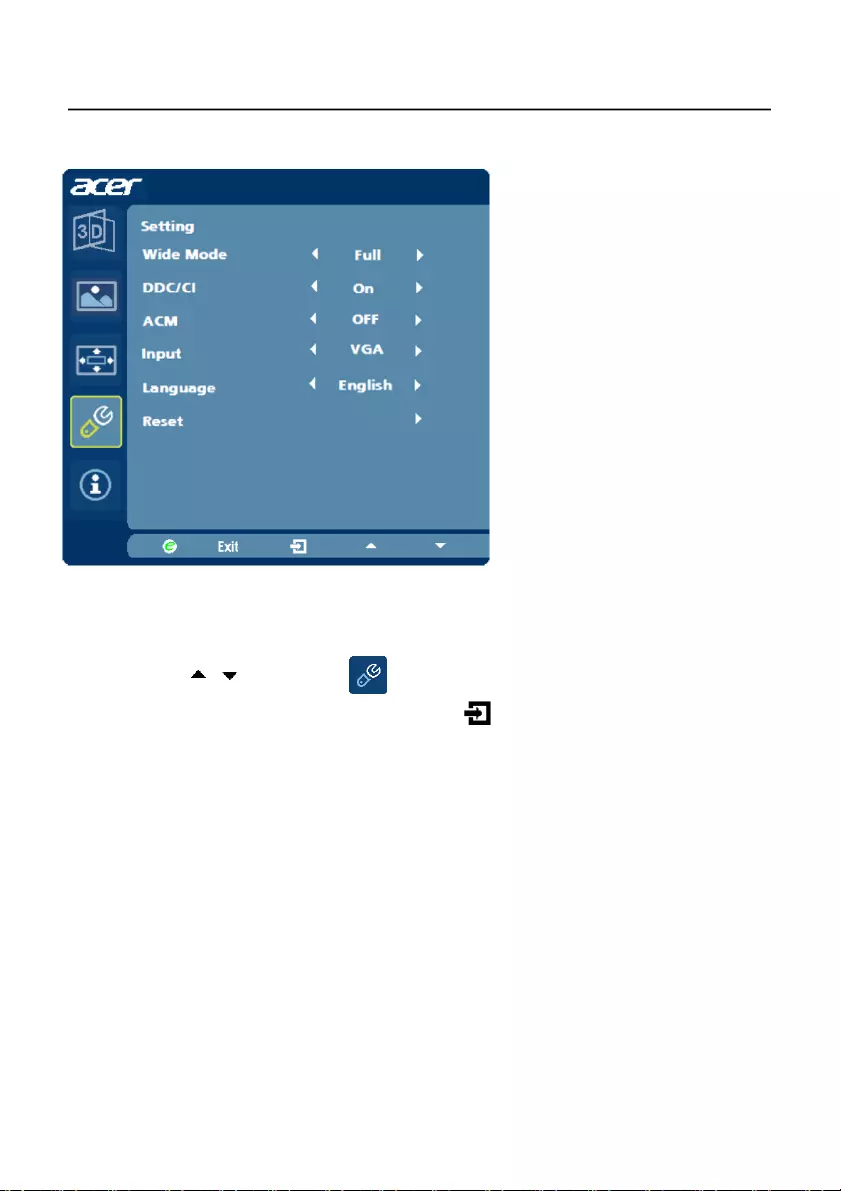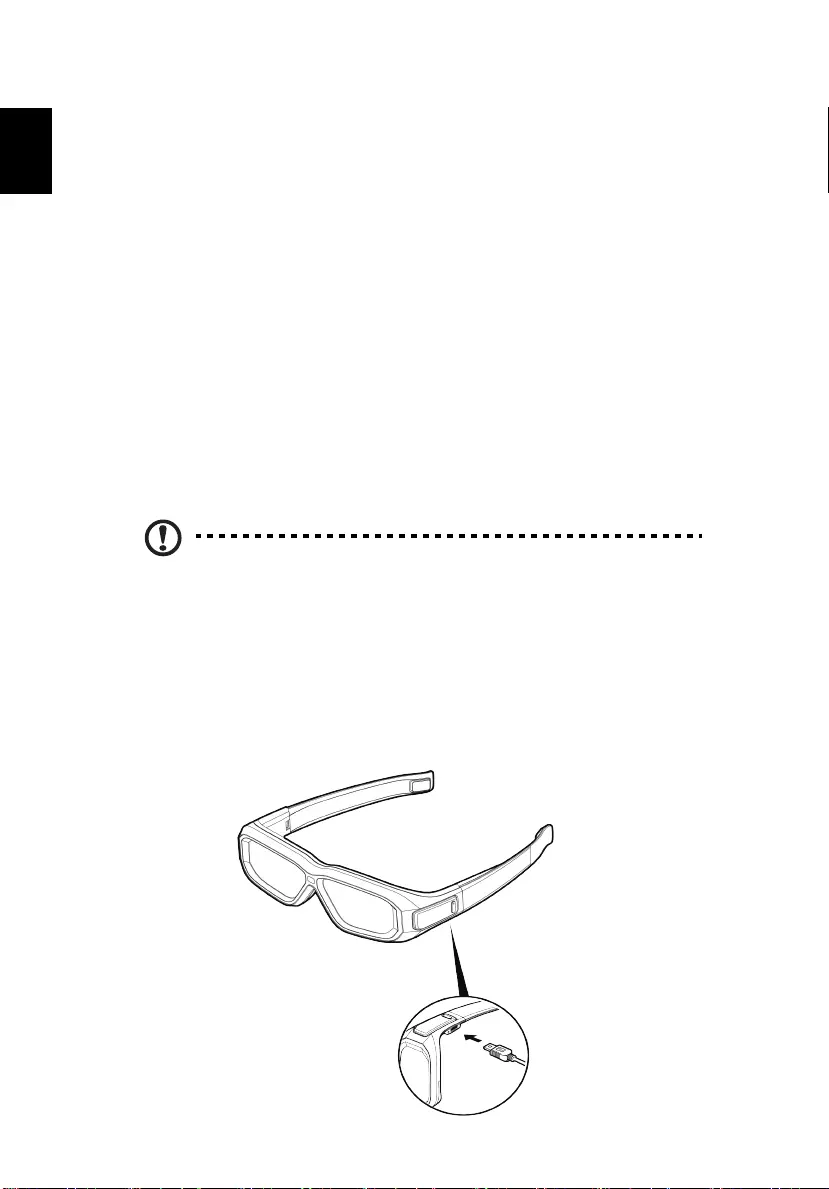Table of Contents
Acer GN246HL Bbid User Manual
Displayed below is the user manual for GN246HL Bbid by Acer which is a product in the Computer Monitors category. This manual has pages.
Related Manuals

TABLE OF CONTENTS
Special notes on LCD monitors..................................................1
Information for your safety and comfort..................................2
Unpacking...................................................................................5
Attaching/Removing the base....................................................6
Screen position adjustment........................................................6
Connecting the power cord.......................................................7
Safety precaution.......................................................................7
Cleaning your monitor...............................................................7
Power saving...............................................................................8
DDC..............................................................................................8
Power adaptor............................................................................8
Connector Pin Assignment.........................................................9
Standard/3D Timing Table..................................................................11
Installation.....................................................................................12
User controls..................................................................................13
Troubleshooting............................................................................19

EN-1
SPECIAL NOTES ON LCD MONITORS
The following symptoms are normal with LCD monitor and do not indicate a
problem.
NOTES
•Due to the nature of the fluorescent light, the screen may flicker during
initial use. Turn off the Power Switch and then turn it on again to make
sure the flicker disappears.
•You may find slightly uneven brightness on the screen depending on the
desktop pattern you use.
•The LCD screen has effective pixels of 99.99% or more. It may include
blemishes of 0.01% or less such as a missing pixel or a pixel lit all of the
time.
•Due to the nature of the LCD screen, an afterimage of the previous screen
may remain after switching the image, when the same image is displayed
for hours. In this case, the screen is recovered slowly by changing the
image or turning off the Power Switch for hours.
3D Experience:
• 3D visual effects require 3D compatible software, nVidia®
3D Vision™ glasses and a compatible 3D graphics card.
For more information visit the nVidia website:
http://www.nvidia.com/page/home.html
Acer monitor is purposed for video and visual display of information
obtained from electronic devices.
•

EN-2
Information for your safety and comfort
Safety instructions
Read these instructions carefully. Keep this document for future reference. Follow all
warnings and instructions marked on the product.
CAUTION for accessibility
Be sure that the power outlet you plug the power cord into is easily accessible and
located as close to the equipment operator as possible. When you need to disconnect
power to the equipment, be sure to unplug the power cord from the electrical outlet.
Warnings
•Do not use this product near water.
•Do not place this product on an unstable cart, stand or table. If the
product falls, it could be seriously damaged.
•Slots and openings are provided for ventilation to ensure reliable operation of
the product and to protect it from overheating. These openings must not be
blocked or covered. The openings should never be blocked by placing the
product on a bed, sofa, rug or other similar surface. This product should never
be placed near or over a radiator or heat register, or in a built-in installation
unless proper ventilation is provided.
•Never push objects of any kind into this product through cabinet
slots as they may touch dangerous voltage points or short-out parts that could
result in a fire or electric shock. Never spill liquid of any kind onto or into the
product.
•To avoid damage of internal components and to prevent battery leakage, do
not place the product on a vibrating surface.
•Never use it under sporting, exercising, or any vibrating environ ment which
will probably cause unexpected short current or damage rotor devices, HDD,
Optical drive, and even exposure risk from lithium battery pack.
Safe listening
Follow these instructions, suggested by hearing experts,to protect your earing.
•Gradually increase the volume until you can hear it clearly and comfortably and
without distortion.
•After setting the volume level, do not increase it afteryour ears adjust.
•Limit the amount of time listening to music at high volume.
•Avoid turning up the volume to block out noisy surroundings.
•Turn the volume down if you can’t hear people speaking near you.
The adapter is only used for this monitor ,do not be used for other purposes.
•
•
Manufacturer: Asian Power Devices Inc., Model: DA-40A19
Manufacturer: Delta Electronics Inc., Model: ADP-40KD BB
Your device uses one of the following power supplies:

EN-3
Product servicing
Do not attempt to service this product yourself, as opening or removing covers may
expose you to dangerous voltage points or other risks. Refer all servicing to qualified
service personnel.
Unplug this product from the wall outlet and refer servicing to qualified service person-
nel when:
•the power cord or plug is damaged, cut or frayed
•liquid was spilled into the product
•the product was exposed to rain or water
•the product has been dropped or the case has been damaged
•the product exhibits a distinct change in performance, indicating a need for service
•the product does not operate normally after following the operating instructions
-----------------------------------------------------------------------------------------------------
Note: Adjust only those controls that are covered by the operating instructions,
since improper adjustment of other controls may result in damage and will
often require extensive work by a qualified technician to restore the product to
normal condition.
LCD Pixel Statement
The LCD unit is produced with high-precision manufacturing techniques. Nevertheless,
some pixels may occasionally misfire or appear as black or red dots. This has no effect on
the recorded image and does not constitute a malfunction.
Tips and information for comfortable use
Computer users may complain of eyestrain and headaches after prolonged use. Users are
also at risk of physical injury after long hours of working in front of a computer. Long
work periods, bad posture, poor work habits, stress, inadequate working conditions,
personal health and other factors greatly increase the risk of physical injury.
Incorrect computer usage may lead to carpal tunnel syndrome, tendonitis, tenosynovitis
or other musculoskeletal disorders. The following symptoms may appear in the hands,
wrists, arms, shoulders, neck or back:
•numbness, or a burning or tingling sensation
•aching, soreness or tenderness
•pain, swelling or throbbing
•stiffness or tightness
•coldness or weakness
If you have these symptoms, or any other recurring or persistent discomfort and/or pain
related to computer use, consult a physician immediately and inform your company’s
health and safety department.
The following section provides tips for more comfortable computer use.
Finding your comfort zone
Find your comfort zone by adjusting the viewing angle of the monitor, using a footrest,
or raising your sitting height to achieve maximum comfort. Observe the following tips:
•refrain from staying too long in one fixed posture
•avoid slouching forward and/or leaning backward
•stand up and walk around regularly to remove the strain on your leg muscles

EN-4
-----------------------------------------------------------------------------------------------------
Warning! We do not recommend using the product on a couch or bed. If this is
unavoidable, work for only short periods, take breaks regularly, and do some
stretching exercises.
-----------------------------------------------------------------------------------------------------
For more information and help in recycling, please visit the following websites:
Worldwide:
http://www.acer-group.com/public/Sustainability/
•take short rests to relax your neck and shoulders
•avoid tensing your muscles or shrugging your shoulders
•install the external display, keyboard and mouse properly and within comfort
able reach
•if you view your monitor more than your documents, place the display at the
center of your desk to minimize neck strain
Taking care of your vision
Long viewing hours, wearing incorrect glasses or contact lenses, glare, excessive room
lighting, poorly focused screens, very small typefaces and low-contrast displays could
stress your eyes. The following sections provide suggestions on how to reduce eyestrain.
Eyes
•Rest your eyes frequently.
•Give your eyes regular breaks by looking away from the monitor and focusing
on a distant point.
•Blink frequently to keep your eyes from drying out.
Display
•Keep your display clean.
•Keep your head at a higher level than the top edge of the display so your eyes
point downward when looking at the middle of the display.
•Adjust the display brightness and/or contrast to a comfortable level for enhanced
text readability and graphics clarity.
•Eliminate glare and reflections by:
•placing your display in such a way that the side faces the window or any light
source
•minimizing room light by using drapes, shades or blinds
•using a task light
•changing the display’s viewing angle
• using a glare-reduction filter
•using a display visor, such as a piece of cardboard extended from the display’s
top front edge
•Avoid adjusting your display to an awkward viewing angle.
•Avoid looking at bright light sources, such as open windows, for extended
periods of time.
Developing good work habits
Develop the following work habits to make your computer use more relaxing and
productive:
•Take short breaks regularly and often.
•Perform some stretching exercises.
•Breathe fresh air as often as possible.
•Exercise regularly and maintain a healthy body.

EN-5
•LCD Monitor
UNPACKING
Please check the following items are present when you unpack the box,
and save the packing materials in case you will need to ship or transport
the monitor in future.
•User Manual
•AC Power Cord •D-Sub Cable
(Optional)
•Quick Start Guide
•DVI Cable
(Optional)
•Power adaptor •HDMI Cable
(Optional)
•Audio Cable
(Optional)
LCD monitor

EN-6
Attaching / Removing the Base
SCREEN POSITION ADJUSTMENT
In oder to optimize the best viewing position, you can adjust the tilt of
the monitor by using both of your hands to hold the edges of the monitor
as shown in the figure below.
The monitor can be adjusted to 15 degrees up or 5 degrees down as indi-
cated by arrow below.
--------------------------------------------------------------------
Note: Remove the monitor and monitor base from its packaging.
Carefully place the monitor face-down on a stable surface -- use a
cloth to avoid scratching the screen.
Install:
Align the release button on the
bottom of the monitor with the
corresponding
slots on the bottom of the base.
Remove:
Depress the release button as
indicated first before removing the
base and follow the arrow direction
to remove it.

EN-7
CONNECTING THE POWER CORD
•Check first to make sure that the power cord you use is the correct type
required for your area.
•This monitor has a universal power supply that allows operation in either
100/120V AC or 220/240 V AC voltage area. No user-adjustment is required.
•Plug one end of the power cord to the AC Inlet, plug another end to a
proper AC outlet.
•For unit using at 120 V AC:
Use a UL Listed Cord Set, Type SVT wire and plug rated 10 A/125 V.
•For unit using at 220/240 V AC (outside of U.S.):
Use a Cord Set consisting of H05VV-F cord and plug rated 10 A, 250 V. The
cord set should have the appropriate safety approvals for the country in
which the equipment will be installed.
SAFETY PRECAUTION
•Avoid placing the monitor, or any other heavy object, on the power cord
to avoid damage to the cable.
•Do not expose the monitor to rain, excessive moisture, or dust.
•Do not cover the ventilation slots or openings of the monitor. Always
put the monitor in a place where there is adequate ventilation.
•Avoid placing the monitor against a bright background or where sun-
light or other light sources may reflect on the face of the monitor. Place
the monitor just below eye level.
•Handle with care when transporting the monitor.
•Refrain from giving shock or scratch to the screen, as screen is fragile.
CLEANING YOUR MONITOR
Please carefully follow the below guidelines when cleaning the monitor.
•Always unplug the monitor before cleaning.
•Use a soft cloth to wipe the screen and cabinet front and sides.

EN-8
Power saving
The monitor will be driven into Power Saving” mode by the control signal
from the display controller, as indicated by the amber-color power LED.
The power saving states will be kept until a control signal has been detected
or the keyboard or mouse is activated. The recovery time from Active OFF
state back to ON state is around 3 seconds.
DDC
To make your installation easier, the monitor is able to Plug and Play with
your system if your system also supports DDC protocol. The DDC (Display
Data Channel) is a communication protocol through which the monitor
automatically informs the host system about its capabilities, for example,
supported resolutions and corresponding timing. The monitor supports
DDC2B standard.
Power Adaptor
Your device uses one of the following power supplies.
State LED
Light
ON Blue
Power Saving
Mode Amber
3D Mode Green
• The adapter is only used for this monitor ,do not be used for other
purposes.
• Your device uses one of the following power supplies:
Manufacturer: Asian Power Devices Inc., Model: DA-40A19
Manufacturer: Delta Electronics Inc., Model: ADP-40KD BB

EN-9
PIN NO. DESCRIPTION PIN NO. DESCRIPTION
1. Red 9. +5V
2. Green 10. Logic Ground
3. Blue 11. Monitor Ground
4. Monitor Ground 12. DDC-Serial Data
5. Self Test 13. H-Sync
6. R-Ground 14. V-Sync
7. G-Ground 15. DDC-Serial Clock
8. B-Ground
CONNECTOR PIN ASSIGNMENT
15-Pin Color Display Signal Cable
1
6
11
5
10
15

EN-10
24-Pin Color Display Signal Cable*
PIN Signal PIN Signal
1. TMDS Data2- 13. TMDS Date 3+
2. TMDS Data2+ 14. +5V Power
3. TMDS Data GND 15. Self Test
4. TMDS Date 4- 16. Hot Plug Detect
5. TMDS Date 4+ 17. TMDS Data 0-
6. DDC Clock 18. TMDS Data 0+
7. DDC Data 19. TMDS Data GND
8. NC 20. TMDS Date 5-
9. TMDS Data1- 21. TMDS Date 5+
10. TMDS Data1+ 22. TMDS Clock GND
11. TMDS Data GND 23. TMDS Clock+
12. TMDS Date 3- 24. TMDS Clock-
19-Pin color display signal cable*
PIN Meaning PIN Meaning
1. TMDS Data2+ 10. TMDS Clock+
2. TMDS Data2 Shield 11. TMDS Clock Shield
3. TMDS Data2– 12. TMDS Clock–
4. TMDS Data1+ 13. CEC
5. TMDS Data1 Shield 14. Reserved (N.C. on
device)
6. TMDS Data1– 15. SCL
7. TMDS Data0+ 16. SDA
8. TMDS Data0 Shield 17. DDC/CEC Ground
9. TMDS Data0– 18. +5V Power
19. Hot Plug Detect
* only for certain models

EN-11
Sta nd a rd Timi ng Ta ble
**Modes that require a dual link DVI cable and compatible graphic card.
3D Timin g T a ble
Mode Resolution
1 1920x2205p 24 Hz
2 1280x1470p 60 Hz
3 1280x1470p 50 Hz
4 1920x1080i 60 Hz
5 1920x1080i 50 Hz
6 1920x1080p 24 Hz
7 1280x720p 60 Hz
8 1280x720p 50 Hz
Mode Resolution
1 VGA 640x480 60 Hz
2 MAC 640x480 66.66 Hz
3 VESA 720x400 70 Hz
4 SVGA 800x600 56 Hz
5 SVGA 800x600 60 Hz
6 XGA 1024x768 60 Hz
7 XGA 1024x768 70 Hz
8 VESA 1152x864 75 Hz
9 WXGA 1280x800 60 Hz
10 SXGA 1280x1024 60 Hz
11 WXGA+ 1440x900 60 Hz
12 UXGA 1920x1080 60 Hz
13 UXGA 1920x1080 144 Hz

EN-12
INSTALLATION
To install the monitor to your host system, please follow the steps as given
below:
Steps
1.1-1 Connect Video Cable
a. Make sure both the monitor and computer are powered-OFF.
b. Connect the VGA video cable to the computer.
1-2 Connect Digital Cable (Only Dual-Input Model)
a. Make sure both the monitor and computer are powered-OFF.
b. Connect one end of the 24-pin DVI cable to the back of the
monitor and connect the other end to the computer’s port.
1-3 Connect HDMI Cable (Only HDMI-Input Model)
a. Make sure both the monitor and computer are powered-OFF.
b. Connect the HDMI cable to the computer.
2. Connect the Audio Cable(Only Audio-Input Model)(Optional)
3.Connect power adaptor and power cord
Connect the power adaptor and power cord to the monitor, then to a
properly grounded AC outlet.
4.Power-ON Monitor and Computer
Power-ON the monitor first, then power-ON the computer.
This sequence is very important.
5.If the monitor still does not function properly, please refer to the
troubleshooting section to diagnose the problem.

EN-13
USER CONTROLS
Power Switch / Power LED:
To turn the monitor ON or OFF.
Lights up to indicate the power is turned ON.
Using the Shortcut Menu
Press the function button to open the shortcut menu. The shortcut menu lets you
quickly select the most commonly accessed settings.
Empowering:
Press the Empowering Key to open the Acer eColor Management OSD and access
the scenario modes.
AUTO Auto Adjust:
Press this button to activate the Auto Adjustment function. The Auto Adjustment
function is used to set the HPos, VPos, Clock and Focus.
MENU OSD functions
Press this botton to activate the OSD menu.
INPUT Input Key
Use Input key to select from different video sources that may be connected to
your monitor.
(a) VGA input (b) DVI input (c) HDMI input
As you cycle through the sources you will see the following messages on right top
side of screen to indicate currently selected input source. It may take 1 or 2
seconds for the image to appear.
VGA or DVI or HDMI
If either VGA or DVI input is selected ,but the VGA and DVI cables are not con-
nected, a floating dialog box indicates:
“No Cable Connect” or “No Signal”

EN-14
Main
Menu
icon
Sub
Menu
icon
Sub
Menu
item Description
N/A User mode User defined. Settings can be fine-tuned to suit any
situation
N/A ECO mode Adjusts the settings to reduce powerconsumption
N/A Standard
mode Default Setting. Reflects native display capability
N/A Grahpic
mode
Enhances colors and emphasize fine detail. Pictures
and photographs appear in vibrant colors with sharp
detail.
N/A Movie
mode
Displays scenes in clearest detail. Presents great
visuals, even in unsuitably-lit environments.
Acer eColor Management
Operation instructions
Step 1: Press “ “ Key to open the Acer eColor Management OSD and
access the scenario modes
Step 2:Press “ “ or “ ” to select the mode
Step 3:Press “ Adjust/Exit “ Key to confirm the mode and run Auto Adjust.
Features and Benefits

EN-15
Adjusting the OSD settings
--------------------------------------------------------------------
Note: The following content is for general reference only. Actual
product specifications may vary.
The OSD can be used for adjusting the settings of your LCD Monitor.
Press the MENU key to open the OSD. You can use the OSD to adjust the
picture quality, OSD Timeout and general settings. For advanced settings,
please refer to following page:
Adjusting the picture quality
1Press the MENU key to bring up the OSD.
2Using the / keys, select Picture from the OSD. Then navigate
to the picture element you wish to adjust. Use the to Enter to the
item page.
3Use the / keys to adjust the sliding scales.
4The Picture menu can be used to adjust the current Brightness, Contrast,
Colour Temp, Auto Config and other image-related qualities.

EN-16
Adjusting the OSD Timeout
1Press the MENU key to bring up the OSD.
2Using the directional keys, select OSD from the on screen display.
Then navigate to the feature you wish to adjust.

EN-17
Adjusting the setting
1Press the MENU key to bring up the OSD.
2Using the / keys, select Setting from the OSD. Then navigate to
the feature you wish to adjust. Use the to Enter to the item page.
3The Setting menu can be used to adjust the screen Menu Language and
other important settings.

EN-18
Product information
1Press the MENU key to bring up the OSD.
2Using the / keys, select Information from the OSD. Then the
basic information of LCD monitor will show up for current input.

EN-19
(VGA Mode)
TROUBLESHOOTING
Before sending your LCD monitor for servicing, please check the trouble-
shooting list below to see if you can self-diagnose the problem.
Problems Current Status Remedy
No Picture
LED ON · Using OSD, adjust brightness and contrast
to maximum or reset to their default
settings.
LED OFF · Check the power switch.
·Check if AC power cord is properly
connected to the monitor.
LED displays
amber color
·Check if video signal cable is properly
connected at the back of monitor.
·Check if the power of computer system is
ON.
Abnormal
Picture
Unstable
Picture
·Check if the specification of graphics
adapter and monitor is in compliance
which may be causing the input signal
frequency mismatch.
Display is
missing, center
shift, or too
small or too
large in display
size
·Using OSD, adjust RESOLUTION, CLOCK,
CLOCK-PHASE, H-POSITION and V-
POSITION with non-standard signals.
·Using OSD, in case of missing full-screen
image, please select other resolution or
other vertical refresh timing.
·Wait for a few seconds after adjusting the
size of the image before changing or
disconnecting the signal cable or powering
OFF the monitor.

EN-20
(DVI/HDMI Mode)
Problems Current Status Remedy
No Picture
LED ON · Using OSD, adjust brightness and
contrast to maximum or reset to their
default settings.
LED OFF · Check the power switch.
·Check if AC power cord is properly
connected to the monitor.
LED displays
amber color
·Check if video signal cable is properly
connected at the back of monitor.
·Check if the power of computer system
is ON.


Acer America Corporation
333 West San Carlos St., San Jose
CA 95110, U. S. A.
Tel : 254-298-4000
Fax : 254-298-4147
www.acer.com
Federal Communications Commission
Declaration of Conformity
This device complies with Part 15 of the FCC Rules. Operation is subject to the following two conditions:
(1) this device may not cause harmful interference, and (2) this device must accept any interference
received, including interference that may cause undesired operation.
The following local Manufacturer /Importer is responsible for this declaration:
Product: LCD Monitor
Model Number: GN246HL
SKU Number: GN246HL xxxxxx
(“x” = 0~9, a ~ z, or A ~ Z)
Name of Responsible Party: Acer America Corporation
Address of Responsible Party:
333 West San Carlos St.
San Jose, CA 95110
U. S. A.
Contact Person: Acer Representative
Phone No.: 254-298-4000
Fax No.: 254-298-4147

3D Monitor
User Guide

Changes may be made periodically to the information in this publication without obligation
to notify any person of such revisions or changes. Such changes will be incorporated in new
editions of this manual or supplementary documents and publications.
This company makes no representations or warranties, either expressed or implied, with
respect to the contents hereof and specifically disclaims the implied warranties of
merchantability or fitness for a particular purpose.
Record the model number, serial number, purchase date and place of purchase information in
the space provided below. The serial number and model number are recorded on the label
affixed to your computer. All correspondence concerning your unit should include the serial
number, model number and purchase information.
No part of this publication may be reproduced, stored in a retrieval system, or transmitted, in
any form or by any means, electronically, mechanically, by photocopy, recording or otherwise,
without the prior written permission of Acer Incorporated.
Model number: __________________________________
Serial number: ___________________________________
Date of purchase: ________________________________
Place of purchase: ________________________________
© 2014
01/2014
All Rights Reserved.
3D Monitor User Guide
Original Issue:

iii
Information for your safety and
comfort
The content in this guide supplements the safety and comfort information
contained in the user documentation that came with your computer.
Safety requirements
Do not wear the wireless glasses in any situation that requires normal visual
perception. Do not use the glasses as sunglasses.
Under normal conditions, stereoscopic 3D viewing is safe for any duration that
you would usually view your display. However, some people may experience
discomfort. To minimize the potential for experiencing visual problems or any
adverse symptoms:
•Take the stereoscopic 3D medical test to verify your ability so see
stereoscopic 3D images.
•Maintain a distance no closer than 2 to 2.5 feet away from the display.
Viewing from too close a distance can strain your eyes.
•Take regular breaks, at least 5 minutes after every hour of stereoscopic 3D
viewing.
•If you experience any of the following symptoms, do not engage in any
potentially hazardous activity (for example, driving a vehicle) until your
symptoms have subsided:
•Nausea, dizziness or queasiness
•Headache or eyestrain
•Blurry vision
Double vision that lasts longer than a few seconds
If symptoms persist, discontinue use and do not resume stereoscopic 3D viewing
without discussing your symptoms with a doctor.
Warning about Epilepsy
IF YOU OR ANY MEMBER OF YOUR FAMILY HAS A HISTORY OF EPILEPSY,
CONSULT A DOCTOR BEFORE USING COMPUTER GAME PRODUCTS.
A small percentage of the population may experience epileptic seizures when
viewing TV images or video games that contain flashing patterns of light.
The following people should consult a doctor before viewing in stereoscopic 3D:
•Children under 5 years of age
•Anyone with a history of epilepsy, or who has a family member with a
history of epilepsy
•Anyone who has ever experienced epileptic seizures or sensory
disturbances triggered by flashing light effects.

iv
Warning about seizures
SOME LIGHT PATTERNS MAY INDUCE SEIZURES IN PERSONS WITH NO PRIOR
HISTORY OF EPILEPSY. DISCONTINUE STEREOSCOPIC 3D USE IF YOU EXPERIENCE
ANY OF THE FOLLOWING SYMPTOMS WHILE VIEWING STEREOSCOPIC 3D
IMAGES:
•Involuntary movements or eye or muscle twitching
•Muscle cramps
•Nausea, dizziness or queasiness
•Convulsions
•Disorientation, confusion, or loss of awareness of your surroundings
Do not engage in any potentially hazardous activity (for example, driving a
vehicle) until your symptoms have completely subsided.
Do not resume stereoscopic 3D viewing without discussing the symptoms with
your doctor.

v
Tips and information for comfortable use
Computer users may complain of eyestrain and headaches after prolonged use.
Users are also at risk of physical injury after long hours of working in front of a
computer. Long work periods, bad posture, poor work habits, stress,
inadequate working conditions, personal health and other factors greatly
increase the risk of physical injury.
Incorrect computer usage may lead to carpal tunnel syndrome, tendonitis,
tenosynovitis or other musculoskeletal disorders. The following symptoms may
appear in the hands, wrists, arms, shoulders, neck or back:
•Numbness, or a burning or tingling sensation
•Aching, soreness or tenderness
•Pain, swelling or throbbing
•Stiffness or tightness
•Coldness or weakness
If you have these symptoms, or any other recurring or persistent discomfort
and/or pain related to computer use, consult a physician immediately and
inform your company's health and safety department.
The following section provides tips for more comfortable computer use.
Finding your comfort zone
Find your comfort zone by adjusting the viewing angle of the monitor, using a
footrest, or raising your sitting height to achieve maximum comfort. Observe
the following tips:
•Refrain from staying too long in one fixed posture
•Avoid slouching forward and/or leaning backward
•Stand up and walk around regularly to remove the strain on your leg
muscles
•Take short rests to relax your neck and shoulders
•Avoid tensing your muscles or shrugging your shoulders
•Install the external display, keyboard and mouse properly and within
comfortable reach
•If you view your monitor more than your documents, place the display at
the center of your desk to minimize neck strain
Taking care of your vision
Long viewing hours, wearing incorrect glasses or contact lenses, glare, excessive
room lighting, poorly focused screens, very small typefaces and low-contrast
displays could stress your eyes. The following sections provide suggestions on
how to reduce eyestrain.

vi
Eyes
•Rest your eyes frequently.
•Give your eyes regular breaks by looking away from the monitor and
focusing on a distant point.
•Blink frequently to keep your eyes from drying out.
Display
•Keep your display clean.
•Keep your head at a higher level than the top edge of the display so your
eyes point downward when looking at the middle of the display.
•Adjust the display brightness and/or contrast to a comfortable level for
enhanced text readability and graphics clarity.
•Eliminate glare and reflections by:
•Placing your display in such a way that the side faces the window or
any light source
•Minimizing room light by using drapes, shades or blinds
•Using a task light
•Changing the display's viewing angle
•Using a glare-reduction filter
•Using a display visor, such as a piece of cardboard extended from the
display's top front edge
•Avoid adjusting your display to an awkward viewing angle.
•Avoid looking at bright light sources, such as open windows, for extended
periods of time.

Information for your safety and comfort iii
Safety requirements iii
Warning about Epilepsy iii
Warning about seizures iv
Tips and information for comfortable use v
Introducing 3D technology 1
Wireless glasses 1
Charging the glasses 1
Using the glasses 2
Hardware Installation 3
Setting up 3D Vision (Dual DVI to PC) 3
Connecting the display 3
Frequently asked questions 5
3D Vision is not working 5
Excessive flickering 5
Eyestrain/headache 6
3D content isn’t shown correctly on the display 6
Contents

1
English
Introducing 3D technology
The Acer 3D monitor you have purchased supports NVIDIA 3D Vision technology
to deliver a fully immersive stereoscopic 3D experience. And, with the use of
high-tech wireless glasses, the 3D Vision kit transforms hundreds of PC games
and digital photographs into an eye-popping interactive experience.
Just slip on the glasses to see characters and environments come to life on the
screen.
3D Vision automatically transforms hundreds of PC games into full stereoscopic
3D. Visit www.nvidia.com/3dvision for a full list of supported games and
applications.
Wireless glasses
Charging the glasses
Note: We recommend that you fully charge your glasses now since
it will take approximately three hours to complete. The wireless
glasses hold approximately 40-hours of gaming per full charge.
The wireless glasses require periodic charging. To charge the glasses, use one of
the USB cables that came with the kit. Plug one end into the glasses and the
other to any USB port on your PC. You can also use a USB wall adapter to
charge your glasses. Charge your glasses until the amber charge light goes out.
You can use wireless glasses while they are being charged.

2
English
If you are charging the wireless glasses by connecting them to your PC using a
USB cable, make sure your PC does not go into power save mode. When your PC
goes into power save mode, the wireless glasses are no longer charging. To fix
this, disable any power-saving options on your PC under the Windows Control
Panel. Alternatively, you can use a USB wall charging device to charge the
glasses directly from your wall power outlet without connecting to the PC. You
can use your glasses while they are charging.
Using the glasses
It is a good idea to keep the glasses in the protective pouch when you are not
using them. When wearing your glasses, you must be in line-of-sight with the IR
emitter. Press the ON button to turn the glasses on. The glasses turn off
automatically when there is no activity.
Warning: The wireless glasses are not prescription eye wear,
sunglasses, nor protective goggles. Do not use the glasses for any
general eye wear purposes (e.g. driving, reading, protection from
sunlight or ultraviolet light, etc.) as such use may result in injury.

3
English
Hardware Installation
Setting up 3D Vision (Dual DVI to PC)
Connecting the display
Connect your 3D Vision Ready display to your NVIDIA graphics card. Use the
dual-link DVI-to-DVI cable supplied with the display.
Note: Connect ONLY the display now. The driver and software
must be installed prior to connecting the USB IR Emitter.
Note: Compatible graphics cards include: NVIDIA GeForce 8 Series
(8800GT+), 9 Series (9600GT+) or GTX 200 Series. For more
information, please visit:
www.nvidia.com/object/3d-vision-requirements.html

4
English
IR Emitter
PC
3D LCD
DVI
DO NOT MAKE THIS
CONNECTION UNTIL TOLD
TO DO SO BY THE INSTALL
WIZARD
USB Cable
Dual Link DVI cable
(supplied with the display)
USB DVI

5
English
Frequently asked questions
NVIDIA provides an online knowledge-base system with answers to most
common questions, available 24x7x365. You can also use it to submit questions
online to our technical support staff. For more details please visit
www.nvidia.com/3dvision/support.
Note: Questions may only be submitted in English.
NVIDIA recommends you register your wireless glasses for support at
www.nvidia.com/3dvision/register.
3D Vision is not working
Re-evaluate your setup: Ensure there is direct line-of-sight between the IR
emitter and your wireless glasses at a range of at least 1.5 feet (45 cm) or
greater. Any obstruction may cause the lenses to flicker or turn off.
Do not place objects in front of the emitter, as this could block the signal. Also,
make sure not to place your hand or other objects in front the of the IR receiver
on the glasses; this is located near the front left lens. Ensure your wireless
glasses are fully charged.
You can check the battery level of your glasses by pressing the ON button.
•If the light next to the button is green, you have up to 40 hours of battery
life remaining. Actual battery life is dependent on the recharge time.
•If the light is red, you have less than two hours remaining and it is
recommended that you recharge your glasses.
•If the light does not turn on, the battery is drained and the glasses must be
recharged.
If you are charging the wireless glasses by connecting them to your PC using a
USB cable, make sure your PC does not go into power-save mode. When your PC
goes into power-save mode, the wireless glasses are no longer charging. To fix
this, disable any power-saving options on your PC under the Windows Control
Panel. Alternatively, you can use a USB wall charging device to charge the
glasses directly from your wall power outlet without connecting to the PC.
Excessive flickering
Flicker in your peripheral vision can be caused by differences in frequencies at
which 3D Vision operates and the lighting in your room. This type of flicker can
be avoided by turning off the lights or changing the stereoscopic 3D refresh
rate. To see the refresh rates, run the Setup Wizard from the NVIDIA Control
Panel. When you get to the page asking about flicker, select Yes. You can then
select from the following refresh rates:

6
English
•120 Hz refresh rate for use in North America when lights are on
•110 Hz refresh rate for daytime and when lights are off
•100 Hz refresh rate for countries with 50 Hz lighting and
when lights are on
Once you have selected a refresh rate on the Setup Wizard screen, click Test to
verify the new refresh rate which also helps reduce flickering. Once you have
found the best setting, click Next to continue.
Eyestrain/headache
If you are experiencing eyestrain or headaches, it could be due to excessive
depth amount set to view the stereoscopic 3D.
Warning: If eyestrain and headaches persist, discontinue viewing
in stereoscopic 3D and consult a doctor.
3D content isn’t shown correctly on the display
Make sure that your source device supports D-DVI. Please refer to your
source device’s specifications to ensure correct functionality.